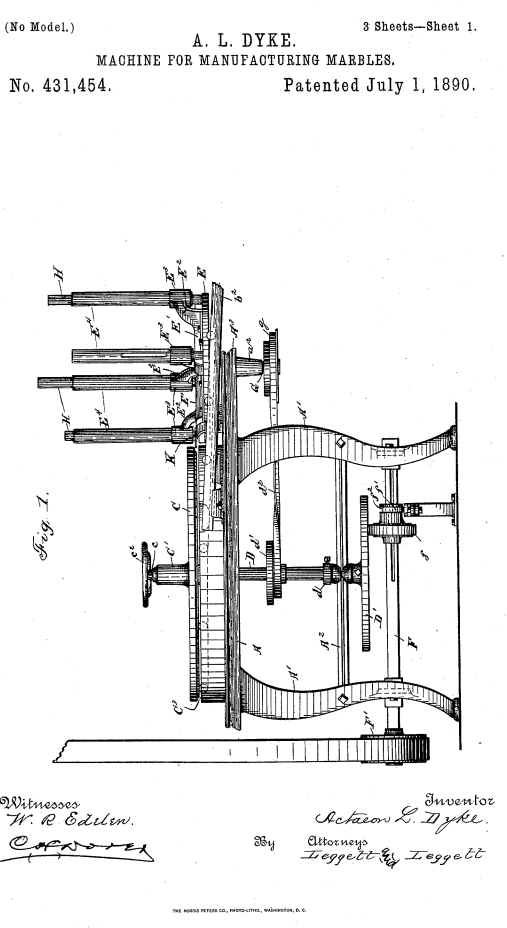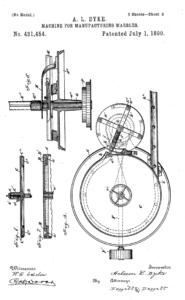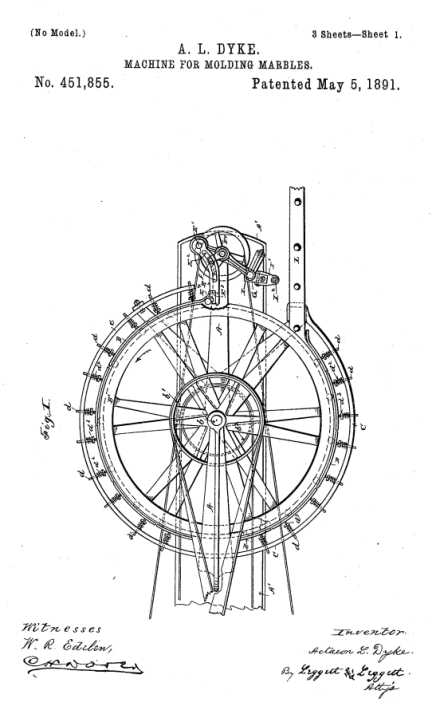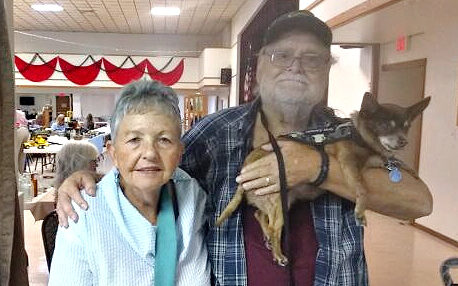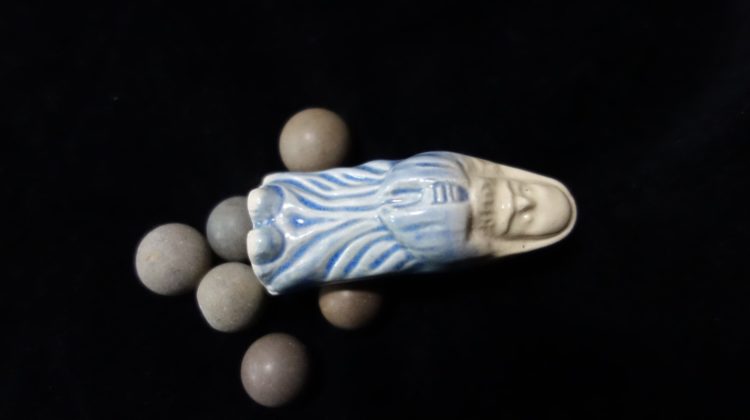
Most of us marble enthusiasts who have collected for a while, been to some marble shows, read marble posts, and made friends in the community, and who have bought, sold, bartered, and given away marbles for years, have at least a basic knowledge of Akron, Ohio, in the 1890s. This was a time of fevered industrial expansion and entrepreneurship; fortunes were made and just as quickly lost. Friendships were also made as inventors and investors collaborated on new projects, and sometimes friends were lost even among siblings.
And in the midst of all the this hustle and bustle were two brothers who, at various times while in Akron, lived together with their families, collaborated on new and exciting projects in the toy business, worked together, and, at times, became fierce competitors. Still, these two brothers created not only millions of new toys, they were largely responsible for the revolutionary new American toy industry. For the first time, manufacturers were making a product for a child!
These were the Dyke brothers: Actaeon L. (generally referred to as A.L.) and Samuel Comley (often referred to as Sam). And most of us probably know something about Sam Dyke. But what is known about Sam’s older brother Actaeon (Acton)?
A. L. Dyke? Which One?
We found our research into the life and times of Acton L. Dyke was some of the most difficult that we have ever attempted. But before we get into the many problems, differing records, records lost in fires, total lack of corroborating records or no records at all, and his complex working history and many moves, we want to ask you another question. Did you know that there was more than one A. L. Dyke who was contemporary with the marble man? Neither did we, but there were at least two more at that time!
A.L. Dyke: Peanut Peddler
From The Marysville Tribune November 23, 1870[1]
“…A.L. Dyke, a train boy on the Kansas Pacific Railroad started for England in obedience to a summons by telegraph.” Dyke also sold apples, peanuts, and newspapers on the train. Vendors on the train were expected by the passengers and, for some odd reason, a boy who sold only newspapers on the train or trolley was called a butcher. The Tribune continues that Dyke had inherited property from his uncle valued at $1,250,000! That would be worth $29,611,260 today!
It seems that Dyke’s former home was in Cheltenham, England, and that he had immigrated to America in about 1862. While we enjoyed this “rags to riches” story, what caught our attention at first was the boy’s hometown in England: Cheltenham. We remembered that A.L., the Akron marble man, had been born in Gloucester and Gloucester and Cheltenham are only about ten miles apart. Both are in Gloucestershire County! Coincidence?
A.L. Dyke & His Steam Carriage!
The other A.L. Dyke invented a steam car and founded a Steam carriage company. And he sold his cars as kits! You can see a photograph of a handsome steam outfit at https://tnmot.org/collection/a-l-dike-steam-car/ . The man who contributed the Dyke car to the museum featured in this website found it in the 1950s unassembled in a barn. Here is some more information from the same website: “Established in St. Louis MO in 1899 by A. L. Dyke (Andrew Lee Dyke), Dyke was the first American auto parts distributor. Dyke also sold early autos, kit cars or assembled. In addition to the Dyke name, the company also sold automobiles under the St. Louis Motor Company and Dyke-Britton names.”
Can you even imagine receiving a steam carriage in a kit? It puts “Some assembly required” in a whole new light!
A.L. Dyke the Marble Man
With these two red herrings out of the way we tried to focus on A.L. Dyke who owned and ran an established business at 147 South Howard Street in Akron for at least twenty years. The Akron City Directory 1892-1893 (page 266) tells us that A.L., whose wife was Francis, had a retail business at 147 South Howard Street where he sold books, stationery, cigars, tobacco, and confectionary. He was also a general news dealer. In this same directory Sam, whose wife was Belle, was Superintendent of the American Marble and Toy Manufacturing Company.
According to online Summit Memory “Howard Street was Akron’s main roadway in the 19th century. With the close of the Pennsylvania and Ohio Canal in the late 1800s, Akron’s current Main Street was built over top of the abandoned canal. Main Street became the new thoroughfare in Akron, and Howard Street transformed into a unique multicultural district.”[2]
We find it interesting that the Akron City Directory 1896 reports that sundries proprietor A.L. Dyke was General Manager of The American Marble & Toy Manufacturing Company while Samuel C. is listed simply as a “potter”. Incidentally, The American Marble & Toy Manufacturing Company became the largest toy company in the United States in the 19th century.
Michael C. Cohill
The unquestioned authority on the birth of the American toy industry is Michael C. Cohill. Michael wrote the book A Spin on the Past The Origin Story of the Modern American Toy Industry, as it Occurred in Akron, Ohio, Including the Story of S.C. Dyke and the First Mass-Produced Toy—Clay marbles.[3]
While our small contribution on A.L. Dyke, which still has many missing parts, is certainly not as comprehensive as Cohill’s, we simply want to add a few notes to the discussion. After a lengthy examination of the available records, conversations with professional researchers and archivists in Museums, and countless emails, we are confident that both S.C. and A.L. contributed to the invention, development, manufacture, and distribution of toys in Akron in the 1890s. We simply wish to acknowledge that Acton Dyke played significant roles in this process.
A.L. Dyke: In the Beginning
Cohill tells us that “a few years before the Civil War began, Garrettsville, Ohio was not much more than the sleepy crossroads of an agricultural village. It is here that John and [Mary] Ellen [Johnson] Dyke, recent immigrants from Devonshire, England, briefly settled in hopes of raising a family. Samuel Comely Dyke, their second child, was born in or very near Garrettsville on July 2, 1856” (page 7).
Today Garrettsville, where Sam was born, has a population of about 2,500 and it is in Portage City northeast of downtown Akron. And today Garrettsville is part of the Akron metropolitan area. Devonshire, where the Dyke family immigrated from, is about 125 miles by car from Gloustershire[4] where A.L. was born in Northleach, Cotswald District, Gloustershire, on October 26, 1851.[5]
All My Siblings
Oddly, while Find a Grave® is comprehensive, Sam is not listed there as A.L.’s brother! While we found this strange, we also found that A.L. is not mentioned in Sam’s obituary which was published in The Parkersburg Sentinel on May 10, 1924[6]! Sam’s children are listed in the obituary along with the short sentence: “Three brothers also survive.” In fact four brothers survived him. One of them was A.L. We had thought all along that the disagreements between A.L. and Sam in Akron simply reflected discord in the two men’s different approaches to business, inventions, and probably fiscal affairs.
Both were creative, energetic, and intelligent. However, perhaps there was a deeper bitterness born and fostered in Akron that the two men never got over.
While A.L. was Sam’s older brother, he was not the oldest brother in the large family. The oldest was Thomas Johnson “John” Dyke who was born in England in 1848. John died in 1927 aged 78-79. He died in Iowa. Cohill tells us on page 7 that John, Acton’s father, “…moved his growing family to Panola, Illinois, then to Indianola, Ohio and finally settled for good in the wild prairies of Iowa.” While there is an Indianola Park in Columbus, Ohio, we cannot locate a town named Indianola in Ohio. The son John died in Indianola, Warren County, Iowa.
Albert Henry Dyke was also older than Sam. He was born in England in 1849 and he died in Valley Junction, Polk County, Iowa, in 1930. The only girl in the family, Lolotto C. “Lottie” Dyke was born in 1854 and she died very young at 54 in 1908. She died in El Paso, Woodford County, Illinois.
Finally, Sam had one younger brother named Darrell Frank. He was born during the Civil War in 1863 and he died in Los Angeles in 1946, four years after A.L. died in Michigan.
Remember Gloustershire?
A.L. Dyke the peanut and sundries seller on the train was summoned to Cheltenham, Gloustershire County, England, from where he had immigrated in 1862. Acton turned nine in 1862; he was 17-18 in 1870 when the train vendor was called home. And A.L. later owned and operated a sundries business on Howard Street for decades! An odd coincidence?
Back to America — & More Mysteries
Acton’s Certificate of Death[7] (Michigan) reports his birthplace as Ohio.
Sam and Acton’s business lives intertwined from an early age. When A.L. was about 19 Sam, then 14, traveled back east – “hopping from riverboat, to canal boat, to Great Lakes steamer, making his way to New York while working as a cabin boy. His big brother, A.L., lived in Buffalo[8].” We had never known the Dyke brothers lived in Buffalo.
“A.L. was in the newspaper delivery business [in New York], and he put Sam to work as a news butcher. A news butcher is a young boy who sells newspapers to customers sitting on streetcars. The idea was for the boy to hitch a ride on the streetcar and walk down the aisle hawking his rags (i.e., selling his newspapers). The conductor would allow the little butcher aboard as a convenience to his passengers.”[9]
Another odd coincidence: remember the millionaire peanut vendor named A.L. Dyke?
Down to Business
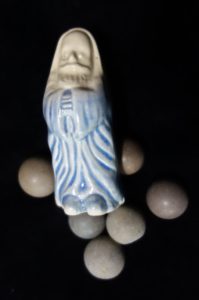 There is no possible way for us to approach this story chronologically. Even with only two major players, it is much too complex. Still, we will certainly put dates on all our research.
There is no possible way for us to approach this story chronologically. Even with only two major players, it is much too complex. Still, we will certainly put dates on all our research.
Blue Santa is a good place to start[10]
“The Blue Santa, pictured here, was discovered at Lock 3 Park in Akron, Ohio, during an archeological dig in 2001 by The American Toy Marble Museum. It was made at the site in the mid-1890s by Samuel C. Dyke’s American Marble & Toy Manufacturing Co…. This company made the world’s first mass-produce toys. They made a million clay marbles a day, five-railroad box car full, and dozens of other penny toys.” Santa was a large penny toy and it is documented to be the oldest three-dimensional image of Santa Claus known to exist (ideastream.org).
The Dyke brothers had moved from Buffalo to Akron in 1879, and we have no evidence of what happened in Buffalo or why they chose Akron to move to. In fact, we cannot be sure why they moved together. As Cohill writes what happened is long lost to history. Sam was 23 and A.L. was about 28. “Sam and A.L. lived together in a house that still stands at 129 South Maple Street, in Akron’s near west side. That year, A. L. opened a small newsstand in an old hotel located in the heart of Akron’s business district. He sold candy, books, newspapers, magazines, tobacco, playing cards and certain personal items a traveler might need while staying at the hotel” (Cohill page 8).
Rock & Roll
We’re sure that you have noticed the stone marbles in the Santa photo. To our knowledge S.C. did not make these. Cohill (pages 31-32) tells us about S.C. making stone marbles, but it is almost an historical footnote now.
The Akron Beacon and Republican[11] (1892) tells us that “the first attempt to manufacture stone marbles in this country will be made this week by the newly organized Akron Stone Marble Company.” It seems that the Company, managed by S.C. and located in Boston, Summit County, Ohio, had leased “…the old flour mill and water power … and the necessary machinery.”
Now this next part is extraordinary. S.C. planned to start off with twenty to thirty people and he planned ten runs a day to produce 200,000 stone marbles a day!
Akron Toy Company 1883
Considering their often tempestuous relationship it is almost impossible to sort out the story of the first American Toy Company. We have read that Acton worked closely with Sam to establish the Company in 1883. Some said that A.L. “Wormed his way” into the Business.
On the other hand “the first fellow to openly compete with Sam turned out to be his brother, A.L.. In a letter, one of Sam’s grandsons wrote that A.L. had somehow ‘wormed his way into the business’ (letter from Sam Brightenson to Fred G. Wright). … There were a number of times when the two of them lived and worked together and got along famously. Then their relationship would bust-to-hell, and they would split-up to become bitter rivals for a time. This makes it all the more difficult to clearly establish what, where and with whom Sam was working in the years between 1884 and 1888. What is clear is that, in the year 1889, the city directories listed A.L. as a manufacturer of toy marbles” (Cohill page 23).
We won’t argue with primary documentation, but it does seem odd to us that A.L., a well-established and respected businessman in Akron for decades, and a former newspaper man, would need to worm his way into anything. In the case of the Akron Toy Company we take the phrase to mean that A.L. insinuated himself to Sam to gain some type advantage for himself.
Remember, we are talking about the same A.L. who had an established newspaper business in Buffalo and who hired his little brother Sam to work as a butcher or vendor on the trolley. A.L. did not sale his 147 South Howard Street store until 1894. Surely he had some capital put back which he could have invested in the Akron Toy Company.
Akron Toy Company Output
This photograph shows two Dyke clays: the red and green which are almost center shot. Other marbles in the shot are a primitive clay, top, a stone, center, a German swirl, and one glass. These are representative of the marbles in existence or being made when the Dykes launched their marble business.
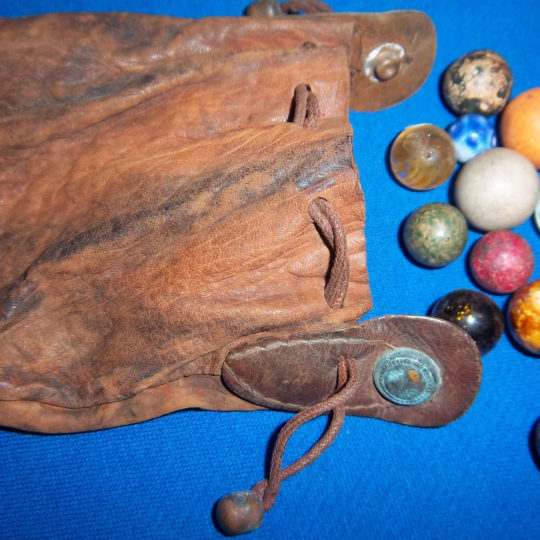 Were the industrial toy marbles mass produced by S.C. the very first in America? We cannot imagine a definitive sentence being parsed any more than the ones written about this central idea.
Were the industrial toy marbles mass produced by S.C. the very first in America? We cannot imagine a definitive sentence being parsed any more than the ones written about this central idea.
In 1888 The Summit County Beacon[12] in Akron wrote: “In a recent issue of The Beacon it was stated that S.C. Dyke & Co. began manufacture of clay marbles a few days since that this was the first instance of marbles being made in the U.S. The facts will hardly bear this out. In 1840 and for several years following Mr. Jabis Voder manufactured clay marbles at East Liverpool, Ohio, and Mr. Henry Gibbs, of the Sixth Ward [Akron] was for a time traveling salesman for him. In 1850 Mr. James Gibbs …manufactured the same kind of marbles at Alton, Ill. Mr. G. with the help of his son carried on the business at Alton for a number of years. So much for the facts in the case.”
1890: Year of Three US Patents
On July 1st 1890 A.L. was granted patent 431454 for a “Machine for Manufacturing Marbles”. Cohill displays Sam’s invention of July 15th but he does not illustrate A.L.’s. Sam’s patent 432127 was for an “Apparatus For Rounding Clay”.
Cohill explains that “The best thing about Sam’s machine was that it was patented, and no one else could use his technique, not even his big brother” (page 24). As for A.L.’s Patent, Cohill writes: “A.L. hired a long experienced ceramics man to invent a very complicated machine to roll chunks of clay around something that looked like a wagon wheel on its side, with a bit of Rube Goldberg[13] thrown in for good measure. (Truthfully, I can’t imagine that A.L.’s machine ever worked as well in the factory as it did on paper…)” (page 24).
Figure 1 at the top of the page above is a side view of A.L.’s machine and it does not show the wheel Cohill describes. We can only imagine that the wheel he describes is pictured in the schematic below. Acton’s machine is complicated and, like Cohill, we have no idea how it responded when placed in marble production. We don’t know whether or not it was ever built and put into production.
If you are interested in the details of 431454 then you can download the entire patent in .PDF format and study its complexities.
On August 12, 1890, A.L. received a Patent (20.104) for a “Shipping and Exhibiting Case.” This is the shortest patent application we have ever seen. It covers about one-third of a page. This case was for both exhibiting marbles and shipping them. The case is “divided into several compartments.” The case could hold a remarkable number of marbles. Again, we have no idea whether or not the marble company used these cases when they started shipping thousands of marbles.
And the Beat goes on: 1891
A.L. writes in this Patent: “My invention relates to improvements in a machine designed more especially for molding marbles; Or, in a more general sense, the machine is well adapted for molding clay or other plastic material into spherical forms….”
Again, we have no idea how useful this patent was on the manufacturing floor or if it ever made it there. But it is simply impossible for us to accept that A.L. Dyke had only marginal roles in the development of marbles and other toys in 1890s Akron.
Jugs Galore!
It is just as mysterious to us how a marble company turned to penny toys to include miniature jugs. We have introduced these little penny toys above when we discussed the Blue Santa. The American Toy Marble Museum has a beautiful color photograph on its website[14] of these jugs, women’s high-top shoes, toy clay glazed cats and dogs, a spool, a “surprise” toy, and miniature flower pots. You should take a look.
In 1888 The Summit County Beacon[15] reports that the little toy jugs had helped to make Akron known all over the United States. In February 1888 the Beacon told us that Sam had been “East” where he made arrangements for machinery to make marbles. He planned to open the plant in Akron and “thereby give Akron the credit of being the only city in America that has a marble factory.”[16]
We have no idea where Sam went. To New York? Who even owned “machinery to make marbles” which they could sell? We think that this factory is the same one Sam used to make penny toys. Who invented and created the molds to make the wide assortment of little clay toys? Sam? A.L.? Someone else? So far we have found no United States Patent for the toys. Would one Patent be enough to cover all of them? Surely someone did not have to apply for a Patent to make each individual toy?
When we visited Akron we found a number of different antique shops in the City and in Summit County. And almost every shop had a variety of these little toys. Our time was limited, and we could not stay to check out garage and yard sales nor estate sales. However, we remember that these toys were expensive! We had money set aside to pay for things for our marble collection, but could not afford these little Dyke toys. When we got home we called some shops but could never get one in the mail.
There was a rather enigmatic post entitled “That Miniature Jug Business” published in the Beacon[17] in August 1887—about a year before the marble factory was fitted out. This report says that “…from a very small beginning in a loft of a barn…manufacture of toy jugs by Mr. S.C. Dyke.” Now here is the odd part: “The jugs now being made by Mr. Dyke are a great improvement over what he formerly made and orders for millions of them are pouring in….”
That’s mysterious. The jugs he made before 1887 were not well made, but the Company will now be selling millions—at a penny each—out of the loft of a barn. And exactly where is A.L. during all this frenzy?
Oh, There’s Acton: How Many Millions?
As early as 1878, The Beacon[18] tells us in the story “Filling Up the Store-Rooms” that A.L., a news contractor of the A. & G.W. Railroad who sells cigars, stationery, &c,..will rent a store room on the east side of Howard Avenue. The story also notes that the area is very busy with some businesses moving out and others moving in.
The A. & G.W. Railroad started as three separate lines: The Erie and New York City Railroad, based in Jamestown, New York; the Meadville Railroad, which was renamed to A. & G.W. in April 1858, and was based in Meadville, Pennsylvania, and; finally, the Franklin and Warren Railroad, which was renamed to A. & G.W. in January 1853, and was based in Franklin Mills, Ohio.[19]
Talking about A.L.’s store at 147 Howard Street where, at this time, he had worked for eleven years and where he employed eight workers: “Last season Mr. Dyke handled for S.C. Dyke & Co….between 5,000,000 and 6,000,000 miniature jugs; he is now introducing marbles…” to his product line. A.L. also had orders for 1,000 Daisy telephones and marble boxes”.
If you can even imagine it, five million jugs, at 1¢ each is equal to $50,000 or about $1,686,554 today; if six million were sold at a penny each then $60,000 was realized or about $2,087,395 today!
As for Daisy telephones: The Akron Telephone Company had begun operations on August 15 1879 at 131 South Howard Street. The telephone company was only a few doors down from A.L.’s store. If anyone can tell us about Daisy Telephones and boxes then please do press the Contact button and tell us all about it. We did learn in The Memphis Appeal[20] that in 1888 a Daisy telephone with wire and instructions sold for $1.00. One thousand dollars earned in 1889 is valued at about $33, 731 in buying power today.
Perhaps as important as money in this short story is the fact that A.L. did sell marbles and penny toys, but he also had a wide variety of merchandise in this shop to include telephones. A.L. had both business acumen as well as an interest in long ranging telephonic and electrical projects.
Inventions are fantastic, but what possible good is any invention if someone doesn’t recognize its value, build it out, and sell its products? We don’t know who else was selling Sam’s products, but without anyone taking orders, writing invoices, selling and shipping, and getting the word out, inventions remain moot.
Thoughts & Things
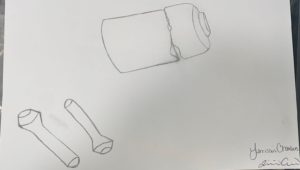 In 1890 A.L. went into marble making while still owning the shop on South Howard. The new operation had two kilns, each 13-foot in diameter. But of most interest to us, considering what was to transpire a few years down the road, was that V.I. Morton was appointed Superintendent of the new firm[21].
In 1890 A.L. went into marble making while still owning the shop on South Howard. The new operation had two kilns, each 13-foot in diameter. But of most interest to us, considering what was to transpire a few years down the road, was that V.I. Morton was appointed Superintendent of the new firm[21].
In 1887 A.L. was selling telephones and in 1889 Sam was busy filling a large order for electric light insulators. We can’t be positive exactly what these insulators were like, but we do know that “knob and tube” wiring[22] was invented about this time. This type wiring dominated the scene until the 1940s. And in all of the early electrical work porcelain knobs and tubes kept the uninsulated electrical wires from touching the wood in homes, businesses, and factories.
“Comprised of single-insulated copper conductors that were installed within walls and ceilings, this wiring was encased in porcelain insulating tubes with cloth lined sleeves, later replaced by rubber, and was supported by porcelain knob insulators that were properly nailed down. The porcelain knobs helped to minimize the risk of fires in the home.”[23]
Incidentally, while working as volunteers at the Osceola County Historical Society in Kissimmee, Florida, we saw a very few tubes with blue Bennington-like glaze and more with a brown Bennington or Rockingham glaze. We have never seen a cloth lined sleeve. However, while conducting research for the Society we learned that these glazed tubes were as much as three times more expensive as unglazed tubes, but the glaze itself offered no more protection from fires nor any other advantage. When use properly they would never be seen.
In 1901 Sam was one of many incorporators of The Electrical Porcelain in East Liverpool, Ohio, and the plan was to build a plant “…for the manufacture of supplies used by electrical companies.”[24] Capital was $30,000.
The most important idea for us now is that both A.L. and Sam, while still in the ceramic business, were looking to the future. The ceramics needed for home and business wiring had to be supplied with power from an external source, and this in turn required transmission of power in high voltages and possibly over long-distances. All of this was new in 1890, and it all required ceramic insulators, capacitors, filter applications, and much more.
Both Sam and A.L. were in on the ground floor of the promising electrical revolution.
Things Fall Apart
The 1890s dawned bright and promising in Akron. Both Dykes were engaged in business and production and they seemed to be at least compatible at this time. Then “in 1893 Sam left his position as Superintendent of The American Marble & Toy Manufacturing Company to start his own venture and A.L. took over as Superintendent. Later, in 1904, when the marble works burnt to the ground, A.L. secretly left Akron owning [owing?] debts to a number of prominent businessmen and was never heard of again.”[25]
There is a long story in The Akron Beacon Journal[26] entitled “American Marble & Toy Manufacturing Company destroyed by fire.” The fire was first noticed about one o’clock on a Monday morning when there had been no fires in the kilns since Saturday. The Robinson Clay Product Company stood nearby.
“The night watchman of the Robinson company had been out a little after one o’clock and had not noticed any signs of fire. But on coming out again in about five minutes he was surprised to see the whole building in flames. …It spread and burned with remarkable rapidity.” It was a suspicious fire.
A.L. was manager and he was in East Liverpool at the time of the fire. While some insurance had lapsed recently, A.L. reported that there was about $6,000 in insurance coverage. However, dozens were now without work and A.L. estimated the loss at about $15,000. A stock company owned the business and A.L. was a principle stockholder.
Toy Snatchers
If there is a bright note to this affair, it would be that the fire left marbles and toys scattered everywhere. Boys gathered and began to pick up marbles and penny toys by the dozens. A policeman had to be dispatched to quell the frenzy!
Moving On
Did A.L. secretly leave Akron in a cloud of dust? We simply cannot answer this. A.L. was a “prominent businessman” in Akron; did he leave owing “a number” of other prominent businessmen? If so, was the under-insured burned marble business at least one of the reasons? We cannot answer this either. Why did the marble factory burn? The factory was made of “well seasoned” pine. Did the electrical wiring have anything to do with the fire? Or was it arson?
Substantiation
We have researched all of the records we could get our hands on and we cannot substantiate who A.L. left town owing. But do you remember V.I. Morton (Victor)? In 1890 A.L. appointed Morton Superintendent of a new marble factory. At this time A.L. still owned his shop on Howard Street. He went into marble making while still owning the shop on South Howard. The new operation had two kilns, each 13-foot in diameter.
In 1892 Morton filed a suit against A.L. “the well-known marble man” alleging breach of contract. Morton claimed that in 1890 “…he entered into a contract with A.L. Dyke…. He was to superintend the works of the defendant and …was to receive $75 per month and 5% of the net profits of the business…. [Morton] claims that “…he did as contracted until July 31, 1891, when the defendant sold out to the American Marble and Toy Co.”
Morton alleged that while he was superintendent the Company made $13,500 and he was owed $650.00. Morton’s suit also gives us some insight into the Patents that A.L. was awarded during this time period. Morton claimed that he had an agreement with A.L. “…by which he was to make all experiments…” that A.L. desired and that “…any inventions which [A.L.] might make should be patented and after the expenses of patenting and experimentation were paid..,” [Morton] was to have a half interest in the patents. Morton continues that two patents were granted to A.L. at this time and A.L. sold them to the American Marble and Toy Co. for $7,000. Morton claims that he never received any money from these patents.
Do you remember that Cohill told us: “A.L. hired a long experienced ceramics man to invent a very complicated machine to roll chunks of clay around something that looked like a wagon wheel on its side, with a bit of Rube Goldberg[27] thrown in for good measure. (Truthfully, I can’t imagine that A.L.’s machine ever worked as well in the factory as it did on paper…)” (page 24).
Well, was this experienced ceramics man Morton? In his suit Morton says that A.L. made the inventions, applied and paid for patents, and that he made experiments on A.L.’s inventions. So he must be the individual whom Cohill references. And, perhaps most mysterious of all, is the fact that Cohill doubts that he machines ever worked well.
Odd, since Morton claims in his suit that A.L. sold the patents to The American Marble and Toy Company for $7,000! Remember who founded and who remained a principle stakeholder in this Company? Sam Dyke.
Curiouser and Curiouser
We told you at the outset that it has been almost impossible for us to learn who was with which toy and marble company and when. All too often the media failed to report the full incorporated name of the Company.
When we studied the Akron City & Summit County Business Directory 1890-1891, we learned that A.L. was still situated on Howard Street South as a general news and sundries dealer. However there is one curious note: “mfg American agate marbles, etc.” Is this the factory that Morton was superintending and where his suit was based? Or are these the marbles that Sam made in his stone marble venture?
In the same Directory Sam is listed: “mfrs miniature jugs, marbles, stoneware novelties, etc.” And also in Sam’s entry is Harvey F. ?. Harvey’s last name is impossible to read: it may be “Miller”? What exactly was Harvey’s role in the marble and toys plants?
We also studied the Akron City Business Directory 1892-1893. Now Sam is listed as “S.C. & Co.” Again, Harvey F. is listed and with the unreadable last name. The office and works were both at 133 South Main. S.C. & Co? Sam continued to make the same product as in 1891. There were no substantive changes in A.L.’s listing.
Other Marble & Ceramic Makers in the Akron Area
We have intentionally kept our focus, as best we could, on the life and work of Sam & A.L. We have no intention of discussing other individuals who were gifted, risk takers, inventors, and patent holders along the Ohio River Valley at the same time as the Dykes.
But at least a few of them worked directly with the Dykes or had a significant influence on the marble industry. For example, Cohill (page 32) tells us that “the electrical insulator manufacturing process relied upon the invention of Mathew Lang’s injection molding technique. With the correct molds and the right mix of clays Sam easily added electrical insulators to his production capacity.”
By all accounts James Harvey Leighton was a master glass maker. We wrote about him in our story “Mid-Western American Hot Glass” (https://thesecretlifeofmarbles.com/mid-western-american-hot-glass/). Leighton held the US Patent 462,083 for the “Manufacture of Solid Glass Spheres” or marbles. Sam hired Leighton to train Dyke’s workers in making glass marbles.
Finally, we just want to mention Frank Brown who started The Standard Toy Marble Company in his back yard in Akron in 1894. Sam had encouraged Frank to set up the Company. There is a fascinating story about Frank in .PDF format which we encourage you to check out.[28]
Never Heard of Again
Remember that after the tragic marble company fire in 1904 A.L. left town never to be heard of again? Well, that is not 100% true. A.L. was no “dead skip.” However, we have not, so far, fully accounted for his life from 1904 until his death in 1942.
However, as background to his abrupt departure, we checked the Akron City Directory 1903. Here, of course, we find A.L. as General Manager of the American Marble and Toy Mfg. Company. In addition to marbles, the Company was also making electrical insulators and tubing.
Crockery & Glass Journal, a trade journal, tells us that in January 1905 A.L. was promoting a new electrical porcelain factory in New Cumberland, West Virginia and that “Steubenville [Ohio], Pittsburg and New Cumberland capital is interested.”[29] We can only imagine that A.L. chose New Cumberland to promote the factory because of its tri-state location.
Incidentally, New Cumberland is on the Ohio River, and the town is hardly in West Virginia. In fact, Hancock County is the northernmost county in the state. New Cumberland is north of Weirton.
High Potential
One year later, in June of 1906, the trade journal China, Glass & Lamps tells us that A.L., “formerly manager of the Akron Marble & Insulator Co., who has been the general manager for the Standard Porcelain Co., of New Cumberland, W.Va., has resigned his position and will likely start in business for himself. Mr. Dyke is well known throughout the trade in Ohio.”[30] This hardly sounds to us like A.L. was a pariah in the business world.
In October 1906 the trade journal The Clay-Worker reports that The Barberton Pottery, in Barberton, Ohio, “…which was put in the hands of a receiver, has been purchased by the Akron High Potential Porcelain Company, who will operate the same on potential and common insulators. Mr. A.L. Dyke, formerly of New Cumberland, W.Va., is the general manager of the new concern.”[31]
“There will be two separate factories, one for the manufacture of miscellaneous varieties of electric insulators and the other for making the high-voltage insulators similar to those which the Cleveland Construction company has been using for the high-tension wires through Barberton. At present only about 35 potters are at work but Manager [A.L.] Dyke announces that in 30 days more than 150 men will be employed and when the factory is running at the full capacity, which will probably be in about six month, 300 men will be the force.”[32]
The name of the Company was changed in 1910 from Akron High-Potential Porcelain Company to Ohio Insulator Company.[33]
This report is from The Akron Beacon Journal. Does it sound to you like A.L. was persona non grata in Summit County?
A.L.’s work trajectory after his business, and marbles, and jugs contributions sounds perfectly normal to us. In Akron in the 1890s he had his own business, but also worked with Sam in the manufacture of clay marbles and novelties. After the fire he knew that there was little or no future in clay marbles, toys and novelties, and he chose to continue his work in home and business ceramic insulators. And then he moved into the exciting and burgeoning world of high potential ceramics.
You’ve Got Mail!
The last thing about A.L. Dyke is that he had an unclaimed letter at the Clarksburg, WV, post office in February, 1908.[34] We opened this story by introducing some A.L. Dykes who were not our marble man. And so we closed the story with another mystery. Did that unclaimed letter belong to “our” A.L. If so, what was he doing in Clarksburg? We all know that Clarksburg became the home to Akro Agate marbles and that nearby Bridgeport was home to the Masters Companies. But A.L. had only a tangential association with glass making. We can never be sure.
Last Things
Sam died at 67 years old of a paralytic stroke in 1924 in Parkersburg, WV. He had moved to Parkersburg with the General Porcelain Company in 1913.[35]
A.L. died at 92 of Arteriosclerosis (heart disease) on November 28, 1942, in Eloise, Wayne County, Michigan. The death certificate reports that his line of work was manufacturer. We think that that sums it up perfectly.
So, next time you hold a handful of Dyke clay marbles, the next time you see a jar full for sale in an antique store or flea market, take just a moment to look at them more closely. There is a world of history, mystery, and untold secrets in each and every marble. They are from a time and place that will never be again. Time and the world have move on to electronic gaming and screen time. But somehow we are all the poorer that there isn’t an 1890s Akron anymore. There was competition there, inventions, patents, and a whole new world of porcelain came out of Howard Avenue, Main Street, and all the rest.
Finally, did you know that S.P. Dykes of Parkersburg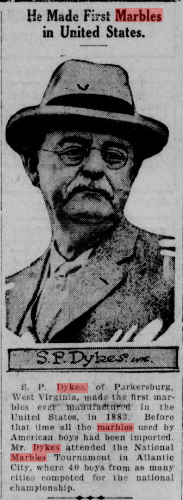 , WV, made the first marbles ever manufactured in the United States. He did! And he did it in 1883! And it has to be true ‘cause we read it in the paper![36] Talk about a mystery!
, WV, made the first marbles ever manufactured in the United States. He did! And he did it in 1883! And it has to be true ‘cause we read it in the paper![36] Talk about a mystery!
References
- Union City, OH, vol. 22, no. 12, p. 2, col. 4. The Marysville Tribune references the Kansas City Journal. While the Kansas City Journal may have been the first to publish the story, we also found it in The Lincoln County Herald (Troy, Lincoln County, MO, November 24, 1870. Library of Congress Control Number sn90061771. We also found The Insulator Gazette (https://reference.insulators.info/publications/list/?format=screen&subject=Dyke 3/14/2024) invaluable to our research. ↑
- https://www.summitmemory.org/digital/collection/clinefelter/id/147/ 4/2/2024
- This book may be available on Amazon, but it is extremely hard to find. Thankfully, there is a .PDF version @ A_Spin_on_the_Past.pdf (akronlibrary.org) (4//2/2024). If you are unfamiliar with The American Toy Marble Museum, then you may want to also check https://americantoymarbles.com/ (4/2/2024). The Museum and its exhibits, marble displays, and other artifacts are no longer at Lock 3 Park in Akron. However, this website is a valuable resource where you can find stories about the Blue Santa which is our principle photograph in this story, as well as about the birth of the American toy industry, all about Lock 3 Park, and much more! Be sure not to miss the feature Glossary of Marble Terms. ↑
- “Researchers have confirmed the first documented history of [the name Dyke] in lowland Scotland and northern England, tracing it through many ancient manuscripts…. The first record of the name Dyke was found in Cumberland where they were seated from ancient times, some say well before the Norman Conquest and the arrival of Duke William at Hastings in 1066…. The spelling of the name [Dike, Dykes, and Dikes, for example] changed frequently, “even between father and son.” The Ancient History of the Distinguished Surname Dyke @ http://www.enable.org/rdyke/dykehist.htm 4/4/2024 ↑
- Find a Grave – Millions of Cemetery Records (4/2/2024) We sincerely appreciate the time, professional research, and helpful advice which Deborah Smith at James A. Garfield Historical Society, Garrettsville, OH provided throughout this project. Find a Grave®, is an online site that allows the public to research and to add to an online database of cemetery records, we learned that People add information to the site by voluntarily walking a cemetery and taking pictures, or from obituaries, other records or from information they have about family members.↑
- “Obituary of Sam Dyke.” The Parkersburg Sentinel, Parkersburg, WV, Saturday, May 10, 1924. ↑
- Certificate of Death, Michigan Department of Health, State File Number 28216541. December 4, 1942. ↑
- Cohill, page 7.
- Ibid. ↑
- Blue Santa & FriendsTM @ http://www.bluesanta.us/blue_santa.htm (4/3/2024) has a six page story all about the Blue Santa of Akron. You may ask “Why a blue Santa?” Well, we aren’t sure, but to our knowledge the “original” Santa was tan or brown. And yes, we have heard of a green Santa. Quora tells us that “in 1863 artist Thomas Nast depicted Santa in a blue coat covered in stars, with red and white striped trousers. In that picture Santa was handing out gifts to Union soldiers.” https://www.quora.com/Was-Santas-suit-originally-blue-If-so-why 4/4/2024 ↑
- The Akron Beacon and Republican, Akron, Ohio, November 29, 1892, vol. 23, no. 303, page 3, column 3. ↑
- The Summit County Beacon, Akron, OH, Wednesday, August 8, 1888, vol. 51, no. 2610, page 5, column 8. ↑
- https://en.wikipedia.org/wiki/Rube_Goldberg_machine (4/6/2024) .
- A.L.’s Patent for making marbles was reported in the Democratic Northwest [volume], Napoleon, OH, July 17, 1890, Image 6.American Toys (americantoymarbles.com) 4/6/2024 ↑
- The Summit County Beacon, Akron, OH, Wednesday, August 1, 1888, vol. 50, no.2609, page 4, col.4. ↑
- The Summit County Beacon, Akron, OH, Wednesday, February 22, 1888, vol. 50, no.2586, page 3, col.1. ↑
- The Summit County Beacon, Akron, OH, Wednesday, August 10, 1887, vol. 50, no.2, page 1, col.6. ↑
- The Summit County Beacon, Akron, OH, Wednesday, November 1887 page 3, col.2. ↑
- Atlantic and Great Western Railroad – Wikipedia 4/7/2024 ↑
- The Memphis Appeal. [volume], March 31, 1888, Page 7, Image 7.↑
- The Summit County Beacon, Akron, OH, Tuesday, January 28, 1890, vol. 21, no.44, page 4, col.2. ↑
- Many thanks to Jurrissia Chambers for her sketch! ↑
- https://www.gervaiselectric.com/understanding-knob-and-tube-wiring-in-old-or-historic-homes/ (4/8/2024). There were many more ceramic parts used in electrical wiring in the 1890s (such as cleats), but there is no reason to go into that here. ↑
- Akron Daily Democrat [volume], September 5, 1901, Page 3, Image 3. ↑
- American Toy Marble Museum, “A Glossary of Marble Players’ Terms” @ http://www.americantoymarbles.com/glossary.htm/ 3/16/2024
- The Akron Beacon Journal, Akron, OH, Tuesday September 6, 1904, vol. 35, no. 236, p. 3, col. 4-5. ↑
- https://en.wikipedia.org/wiki/Rube_Goldberg_machine (4/6/2024). A.L.’s Patent for making marbles was reported in the Democratic Northwest [volume], Napoleon, OH, July 17, 1890, Image 6.↑
- Michael Cohill, “Frank Brown and the Standard Toy Marble Company.” @ Frank-Brown-The-Standard-Toy-Marble-Company.pdf (ohiobottleclub.org) 4/10/2024 ↑
- Crockery & Glass Journal, New York, Thursday, January 26, 1905, vol. 61, no. 4, page 33, col. 1. ↑
- China, Glass & Lamps, Pittsburg, PA, Saturday, June 9, 1906, vol. 26, no. 19, page 5, col. 2. ↑
- The Clay-Worker, Indianapolis, IN. October 1906, October 1906, vol. 46, no. 4, page 393, col. 2. ↑
- The Akron Beacon Journal, Akron, OH, Thursday, November 1, 1906, vo. 37, no. 279, p. 6, col. 3-4. ↑
- The company was originally Akron Hi-Potential Insulator Co. The entire production of that company was sold to Ohio Brass until OB took complete ownership in August 1910 and change the company name to the Ohio Insulator Co. Akron Smoking Pipe Co. purchased their third rail business in 1905. According to 1921 Poor’s and Moody’s, Ohio Brass Co. owned entire $100,000 common stock of The Ohio Insulator Co., “which operates a plant containing 3 acres of floor space located on a tract of land of about 10 acres at Barberton, O., where high tension porcelain insulators are manufactured.” Officers included A. O. Austin of Barberton. In 1937, the name of the plant was changed to Ohio Brass. Ohio Brass made about as many insulators as the Dyke brothers made marbles! If you want to learn more then we recommend that you check “Insulator Companies” @ https://www.r-infinity.com/Companies/ 4/11/2024 ↑
- The Daily Telegram, Clarksburg, WV, February 5, 1908, Image 8. ↑
- The Parkersburg Sentinel, Parkersburg, WV, Saturday, May 10, 1924. ↑
- The Alaska Daily Empire. [volume], July 14, 1923, Page 5, Image 5 ↑


